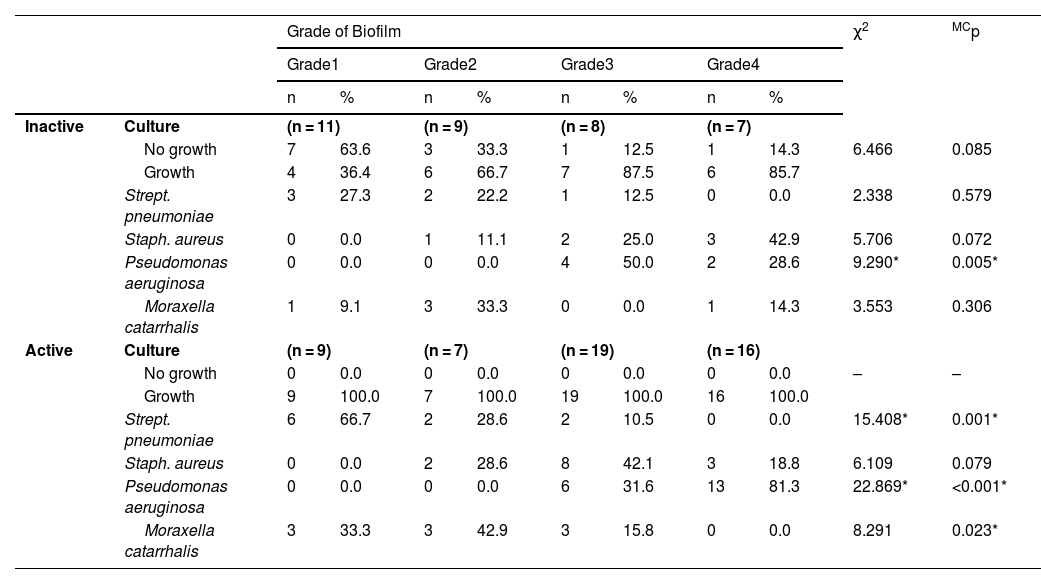To evaluate the bacterial biofilm’s role in mucosal chronic suppurative otitis media (CSOM) utilizing scanning electron microscopy (SEM).
MethodsThis study involved 123 participating patients with active and inactive mucosal CSOM who underwent tympanomastoid surgery. SEM was used to examine middle ear mucosa biopsies for the development of biofilms. Middle ear discharge or mucosal swabs from patients were cultured to detect any bacterial growth. The biofilm formation was correlated to the culture results.
ResultsThe biofilm was present in 69.9 % of patients (59% of them were with active mucosal CSOM) and absent in 30.1% of the patients (70% of them were with inactive mucosal CSOM), being more statistically significant in active mucosal CSOM (p-value = 0.003). A correlation that was statistically significant was found between active mucosal CSOM and higher grades (3 and 4) of biofilms (p-value <0.05). The mucosal CSOM type and the results of the culture had a relationship that was statistically significant (p-value <0.001). 60% of patients had positive culture (70% of them were with active mucosal CSOM). There was a statistically significant relation between Pseudomonas aeruginosa bacterial growth and active mucosal CSOM (p-value = 0.004) as well as higher grades of biofilms in mucosal CSOM.
ConclusionMucosal CSOM, especially the active type, is a biofilm-related disease. There is a significant relation between the state of mucosal CSOM (active or inactive) and culture results with predominance of Pseudomonas aeruginosa bacterial growth in active mucosal CSOM and in higher grades of biofilms in mucosal CSOM.
Evaluar el papel de las biopelículas bacterianas (biofilm) en la otitis media crónica supurativa (OMCS) de tipo mucoso mediante microscopía electrónica de barrido.
MétodosEn este estudio participaron 123 pacientes con OMCS activa e inactiva de tipo mucoso que se someten a cirugía timpanomastoidea. Se utilizó microscopía electrónica de barrido para examinar biopsias de la mucosa del oído medio en busca del desarrollo de biopelículas. Se cultivaron secreciones del oído medio o hisopos de mucosa de los pacientes para detectar cualquier crecimiento bacteriano. La formación de biopelículas se correlacionó con los resultados del cultivo.
ResultadosEl biofilm estuvo presente en el 69,9 % de los pacientes (59% de ellos con OMCS de mucosa activa) y ausente en el 30,1 % de los pacientes (70% de ellos con OMCS de mucosa inactiva), siendo más significativo estadísticamente en OMCS de mucosa activa. (valor p = 0,003). Se encontró una correlación estadísticamente significativa entre la OMCS de la mucosa activa y los grados más altos (3 y 4) de biopelículas (valor de p < 0,05). El tipo de OMCS de la mucosa y los resultados del cultivo tuvieron una relación estadísticamente significativa (valor de p < 0,001). El 60% de los pacientes tuvieron cultivo positivo (el 70% de ellos tenían OMCS mucosa activa). Hubo una relación estadísticamente significativa entre el crecimiento bacteriano de Pseudomonas aeruginosa y la OMCS de la mucosa activa (valor de p = 0,004), así como grados más altos de biopelículas en la OMCS de la mucosa.
ConclusiónEl OMCS de las mucosas, especialmente el tipo activo, es una enfermedad relacionada con el biofilm. Existe una relación significativa entre el estado de la OMCS de la mucosa (activa o inactiva) y los resultados del cultivo, con predominio del crecimiento bacteriano de Pseudomonas aeruginosa en la OMCS activa de la mucosa y en los grados más altos de biopelículas en la OMCS de la mucosa.











